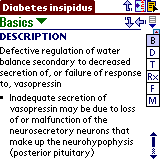Using Bluetooth and GPRS
More ramblings on my Wireless Palm experience using Bluetooth and Digi's GPRS - this is a basic Walk-through
Equipment
Phone: Ericsson t39m. Although this phone is an older model, it's reasonably priced (RM800+) for all the features you are getting including GPRS and Bluetooth built-in. Voice reception is good and with the Ericsson Bluetooth headset you get complete wireless handsfree. The higher end Ericsson t68i costs twice as much but if you fancy colour then go for it.
PDA: Palm m515 (cost RM1350). Good value for money color PDA for first time buyers. Runs on Palm OS 4.1 and has lots of software available form the Internet, many of which are free. Many medical software applications are also available on the Palm format.
Palm accessory: Palm Bluetooth SD card. The m515 does not have built-in Bluetooth (later models with OS 5 are likely to have this built-in). This is a little pricey (RM490). An alternative is the TDK Bluetooth Sled but it's more bulky. Bluetooth allows you to connect wirelessly to your Bluetooth capable phone within about 10 feet range. This is very convenient as the other wireless connection commonly used is IR (Infrared) which requires "line of sight" and is short range. With Bluetooth, your phone could be in your pocket or briefcase and the Palm can still communicate with it.
Setting Up Everything
1. Setting up Bluetooth connection between the Palm and Ericsson t39m
This is fairly straightforward. The Palm BT SD card comes with a CD which installs the appropriate drivers for the Palm and also the Ericsson t39m phone driver (other phone drivers are available from Palm). You need to enable the BT on the Ericsson - change the Operation mode to Always On (Menu 5/Bluetooth/Operation Mode). From the Preferences panel select Phone and make sure the Ericsson BT phone is selected and you can click the Test button to test the connection.
2. Setup the GPRS data connection on the Ericsson t39m and Palm
This information is for Digi since I am using Digi's GPRS service. The service is available for both pre and post-paid Digi users and costs 10s/10kb (post-paid) or 20s/10kb (pre-paid). Post-paid users are charge RM2/mth.
Phone Setup for Internet connection via GPRS for t39m
1. Go to Settings menu and scroll to Data comm
2. Press the Yes button and choose Data accounts
3. Choose Add accounts and press the Yes button
4. Choose GPRS Data and press the Yes button
5. Enter the new account name and press the Yes button
6. Choose APN and press the Yes button
7. Enter the APN and press the Yes button
8. Leave User id and Password empty
9. Scroll down to Save and press the Yes button
10. The phone will prompt ?New GPRS account created?
Field Name Values:
New account name GPRS Internet
APN diginet
User id Nil
Password Nil
Password request Off
Allow calls Automatic
IP Address Nil
DNS Address Nil
Advan.settings Nil
For other GPRS providers or other phones you can consult their respective web pages
Palm Settings
- goto Prefs > Network, create a new Service and put in digi for both User Name and Password
- type in *9***1# for Phone:
- under Details, unselect Query DNS and type in 203.92.128.131 & 203.92.128.132 for the DNS fields
- leave IP Address: Automatic checked
- under Script, make sure you have selected End
- now click OK twice and GPRS on your Palm via BT to your phone is ready to use
If you got all the above working, then your Palm should be able to "talk" wirelessly to the Bluetooth capable phone and also connect to the Internet via Digi's GPRS service.

 What's new in the Palm Medical PDA World? Skyscape has come out with 5 Minute Clinical Consult 2003 and it is not 2003 yet! Looks like a major revamp. Images now optional.:
What's new in the Palm Medical PDA World? Skyscape has come out with 5 Minute Clinical Consult 2003 and it is not 2003 yet! Looks like a major revamp. Images now optional.:
 "
"
 A2Z Drugs
A2Z Drugs 
 The object of my desire......
The object of my desire......

